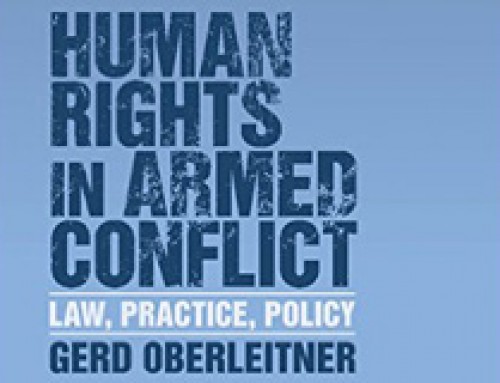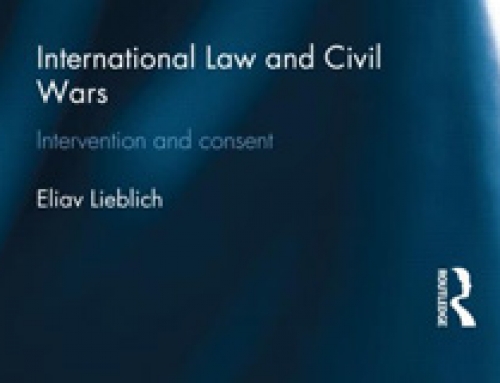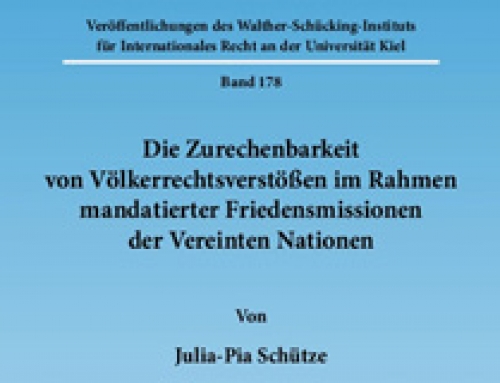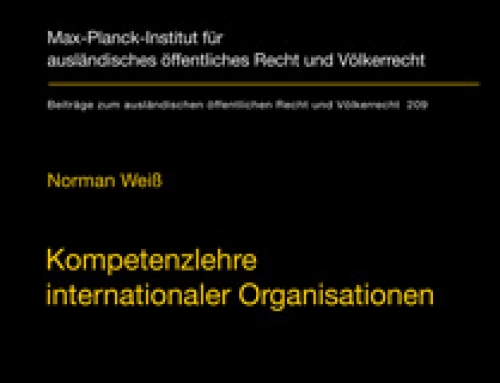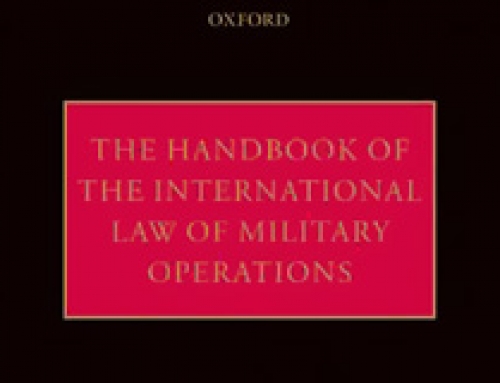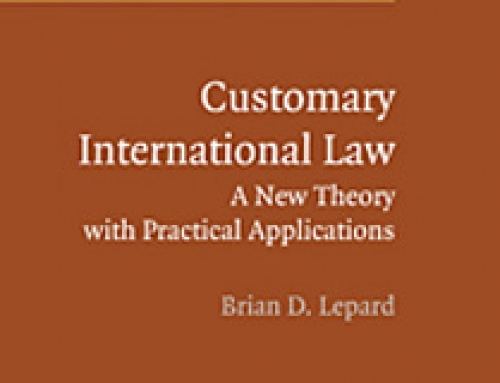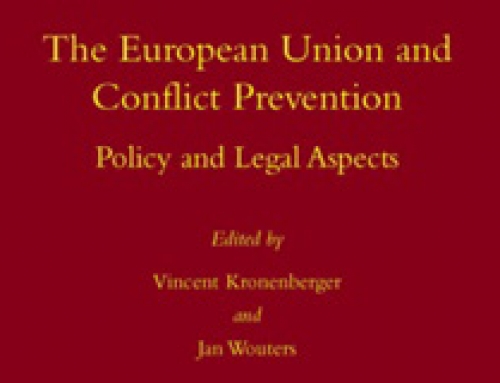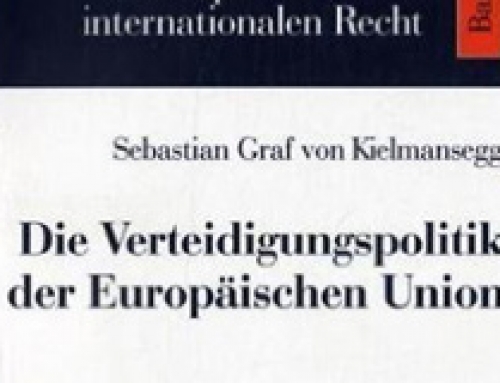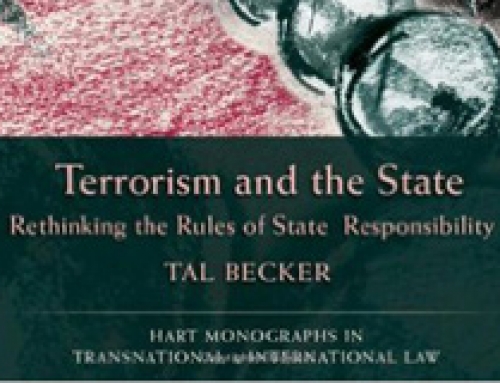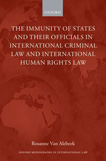
Rosanne van Alebeek, The Immunities of States and their Officials in International Criminal Law and International Human Rights Law. Oxford: Oxford University Press, 2008. 500 pages. ISBN 978-0-19-923247-5. GBP 72.95.
One of the key controversies of international law at its present stage of development concerns the relationship between norms conferring jurisdictional immunities on States and their officials and norms providing for the protection of human rights. The controversy results from the fact that these two sets of rules impose potentially conflicting obligations on States. On the one hand, the principle of State immunity compels States to exempt other States and their officials from the jurisdiction of their courts and tribunals in relation to acts of a governmental or public nature. In addition, States are barred from exercising their adjudicative jurisdiction over certain classes of foreign officials, such as diplomatic agents and heads of State, in relation to acts they perform in their private capacity. On the other hand, States are bound by international human rights law to protect the rights and interests of individual human beings. This duty is reinforced by the rules of international criminal law, which require States to bring those responsible for serious human rights abuses to justice. A conflict between the two sets of obligations may arise when foreign officials benefiting from jurisdictional immunities violate human rights norms. In such cases, the authorities of the forum State may find that they cannot uphold the jurisdictional immunities of the foreign officials and their home State and remedy the alleged breach of international human rights law at the same time.
This dilemma is not an entirely novel one. Claims that war crimes are covered by the principle of State immunity were raised, and defeated, before the International Military Tribunal at Nuremberg and the Supreme Court of Israel in the Eichmann case. However, it is only in recent years that a relatively steady stream of cases concerning the compatibility of jurisdictional immunities with human rights norms has come before national and international courts, including the Pinochet case before the House of Lords, the Al-Adsani case in the European Court of Human Rights and the Arrest Warrant case before the International Court of Justice. It is indicative of the growing significance of this subject that as of early 2009 two cases are pending before the International Court of Justice at once which are directly concerned with the relationship between jurisdictional immunities and international humanitarian and human rights law (Republic of the Congo v. France and Germany v. Italy), together with a third case that touches on this issue incidentally (Belgium v. Senegal).
Rosanne van Alebeek’s work makes an important contribution to the debate concerning the compatibility of jurisdictional immunities with human rights. The principal question of her study is uncomplicated: are the rules exempting States and their officials from foreign adjudicative jurisdiction affected by the development of international human rights law and international criminal law? The answer she offers is more complex. Van Alebeek suggests that the arguments employed by those who proclaim the existence of a human rights exception to jurisdictional immunities and those who deny the existence of such an exception suffer from certain deficiencies. In particular, both camps proceed from problematic assumptions concerning the epistemology of customary international law and an insufficient theorization of the relevant immunity rules. Van Alebeek therefore develops her own thesis in two stages. She first sets herself the task of reconsidering the nature and substance of the rules of State immunity, functional immunity and personal immunity in order to develop a coherent analytical framework in which the scope of these different rules of immunity can be defined. She then proceeds to assess the impact of international human rights law and international criminal law on these immunity rules relying on the analytical framework developed earlier. Given the complexity and merit of van Alebeek’s work, it is worth setting out her arguments in some detail.
Chapter 2 begins by reconsidering the conceptual foundations of the law of State immunity. Based on an overview of State practice, van Alebeek argues that the absolute theory of State immunity has never attained the status of a rule of customary international law. While this revisionist thesis should not raise many eyebrows today, the author draws several wide-ranging conclusions from it. The fact that the law of State immunity did not progress in a linear fashion from an absolute to a restrictive model means that it is misleading to conceive of the restrictive theory simply as the continuation of the absolute theory with certain exceptions attached to it. Such a view conceals the existence of significant qualitative differences between the two theories. Inspired by the writings of Robert Ago, the author suggests that the restrictive theory provides for immunities that are ‘necessary’ in the sense that they are required by the principle of the independence and equality (in short: the sovereign equality) of States. By contrast, the absolute theory provides for immunities that are ‘voluntary’ in as much as they are not required by any structural principle of the international legal system, but are created through the usual processes leading to the formation of customary international law.
Two important methodological points follow from this. First, ‘necessary’ immunity rules prevent the forum State from asserting its adjudicative authority over the exclusive competences of other States protected by the principle of sovereign equality. Consequently, these ‘necessary’ immunity rules reflect substantive, rather than procedural, limits imposed on the legal competence of the forum State by the very structure of the international legal system. The restrictive theory of State immunity is therefore in fact concerned with the lack of the forum State’s jurisdictional competences, rather than the non-exercise of its existing competences as is commonly believed. Second, whereas the existence and scope of ‘voluntary’ rules of immunity can be determined only by way of inductive reasoning taking the form of an analysis of State practice and opinio juris, the scope of the ‘necessary’ rules of immunity may be derived from the principle of sovereign equality by means of deductive reasoning. In other words, logical reasoning concerning the independence and equality of States may be relied on as legitimate arguments for the purposes of determining the scope of immunity rules.
Chapter 3 turns to the functional immunities of State officials. Traditionally, the principle of State immunity is said to extend to individuals who act on behalf of the State as its agents. The immunity of State officials is therefore seen as a consequence of the immunity enjoyed by their home State. The principal difficulty with this view is that it fails to reflect the rationale of functional immunity. As van Alebeek explains, State officials benefit from functional immunity whenever they act on behalf of the State as it is generally accepted that in these circumstances liability should be borne by the State itself. The applicability of functional immunity therefore depends on a distinction between ‘acts of State’, that is act performed on behalf of the State, and private acts serving the individual’s own ends. However, this distinction does not mirror the distinction drawn by the restrictive theory of State immunity between acta jure imperii and acta jure gestionis. Foreign officials may enter into transactions on behalf of their home State which are of a private law character and therefore do not qualify as acta jure imperii, but which nevertheless are covered by functional immunity. This suggests that the functional immunity enjoyed by State officials and the principle of State immunity are in fact two separate concepts. Acts performed on behalf of the State may constitute acta jure imperii, in which case they attract both functional immunity and State immunity. However, such an overlap between functional immunity and State immunity is not inevitable. This leads van Alebeek to conclude that the applicability of functional immunity is a prerequisite for the applicability of State immunity, rather than functional immunity being a consequence of State immunity as the traditional doctrine would have it.
As regards the scope of functional immunity, van Alebeek argues that not every act performed by an individual under the direction of a State will attract functional immunity. Just as the principle of State immunity is restricted to those rules that are ‘necessary’ to safeguard the independence and equality of States, so the principle of functional immunity protects only those transactions of an individual which constitute an exercise of State authority as defined by public international law. This implies that a State cannot extend the functional immunity of its officials unilaterally: no functional immunity attaches to acts that are performed under the direction of a State, but which actually exceed the exercise of its legal authority under international law. The fact that the competence of States in international law is not unlimited thus imposes normative limits on the functional immunity of State officials. A second implication emphasized by the author is that functional immunity should be distinguished from State responsibility. Not every act that can be attributed to the State under the law of State responsibility will attract functional immunity. A State can direct its officials to perform acts that exceed its legal authority in international law. Whereas in such cases the officials do not benefit from functional immunity, the acts concerned nevertheless may engage that State’s international responsibility.
Chapter 4 examines the personal immunities enjoyed by diplomatic agents and heads of State. In the light of the preceding two chapters, it is perhaps unsurprising that van Alebeek describes personal immunities as ‘voluntary’ immunity rules. Immunity ratione personae applies not only to official acts, but also extends to acts performed in a private capacity, subject to certain exceptions. Even though such personal immunities may serve functional purposes in that they enable their beneficiaries to perform their public functions free from foreign interference, the author suggests that this is not their exclusive purpose, nor are personal immunities limited to what is strictly necessary from a functional point of view. Personal immunities thus exceed the bounds of functional immunity as defined in Chapter 3. Their broad scope does not reflect the requirements of the structural principles of the international legal system, but is the result of the separate development of customary international law.
Having thus established a framework of analysis, van Alebeek turns her attention to the impact of international criminal law and human rights law on immunity rules. Chapter 5 is concerned with the effects of international criminal law. In essence, the author contends that by establishing the principle of individual criminal responsibility in conventional and customary international law, States have in effect limited the range of circumstances in which State officials are considered to act in the exercise of State authority. The principle of individual responsibility for crimes committed against international law serves to rebut the assumption that an official has acted within the scope of his or her official mandate. It is important to stress that van Alebeek does not suggest that the development of international criminal law has resulted in the recognition of an ‘international crime exception’ to the functional immunity of State officials. Rather, she argues more radically that international crimes are not acts that can be attributed to the State for the purposes of functional immunity in the first place. The fact that an official ostensibly acting under State authority has incurred individual criminal responsibility defeats the presumption that the official concerned was engaged in the performance of an ‘act of State’. International crimes are not official acts of State for immunity purposes. As van Alebeek formulates, ‘[f]unctional immunity ends where individual responsibility begins’ (at 241).
By treating the functional immunities of State officials as a consequence of State immunity, one of the difficulties that traditional doctrine encounters is that State immunity may extend to State officials in civil proceedings even though the officials concerned do not benefit from immunity in criminal proceedings for the same acts. Imbalances of this kind, as seen in the Jones case before the House of Lords, seem unreasonable and are difficult to justify. Van Alebeek avoids this difficulty by arguing, on the one hand, that functional immunity is conceptually distinct from State immunity and by suggesting, on the other hand, that international crimes fall outside the scope of functional immunity altogether. This position enables her to assert that a State official accused of international crimes does not benefit from immunity in either criminal or civil proceedings, but that the official’s home State may continue to enjoy immunity from foreign adjudicative and enforcement jurisdiction in relation to those crimes. Nevertheless, proceedings instigated against State officials for international crimes may implicate their State indirectly, in particular in the case of crimes that entail some form of official involvement or sanction, such as crimes against humanity and genocide. Van Alebeek therefore suggest, without elaborating this point, that the absence of functional immunity may not suffice on its own to enable foreign courts to entertain cases against State officials implicated in international crimes. Different considerations apply to personal immunities. The principle that an individual’s official capacity does not exempt that person from criminal liability merely extends the principle of individual criminal responsibility to State officials, but it does not thereby remove any personal immunities that they may enjoy. The author accordingly concludes that no human rights exception to personal immunities exists.
Finally, Chapter 6 considers whether the development of human rights law affects the validity and scope of immunity rules. Van Alebeek dismisses the normative hierarchy argument which declares that no immunity can be available for violations of norms of jus cogens. As the author rightly points out, this argument implies that the prohibition of certain conduct permits the enforcement of that prohibition through national courts. However, these are two distinct issues: the normative hierarchy argument remains unconvincing as jus cogens norms and immunity rules operate in different spheres. For good measure, van Alebeek suggests that the delimitation of the competences of States as a consequence of the principle of sovereign equality may itself be considered as a rule of jus cogens avant la lettre. The author also rejects the argument that the gross violation of human rights does not constitute a sovereign function of the State and for that reason is not covered by immunity. Van Alebeek seeks to refute this view by reiterating that the horizontal division of authority between national courts protects the exercise of the exclusive competences of the State from interference by other States. Entitling foreign courts to adjudicate on the exercise of the exclusive competence of another State would violate the independence of that State. However, this argument seems to suffer from circularity. While it is certainly one of the fundamental purposes of the principle of State immunity to protect the exclusive competence of States from outside interference, the scope of this exclusive competence cannot be derived from the principle of non-intervention that the law of State immunity is meant to serve. The principle of non-intervention merely protects the exclusive competences of the State, but it does not define them. More convincingly, van Alebeek goes on to suggests that no human rights exception to the principle of State immunity emerges from the secondary rules of international law, in particular the rules of State responsibility relating to breaches of erga omnes obligations and violations of jus cogens rules.
The final part of Chapter 6 considers the impact of human rights on the level of policy arguments. Based on a close reading of several relevant cases, the details of which cannot be recounted here, van Alebeek suggests that certain tensions exist between immunity rules and the protection of the fundamental rights of individuals. For instance, she criticizes the position adopted by the European Court of Human Rights in Al-Adsani that State immunity rules do not violate the right of access to court because such rules serve a legitimate aim and are proportionate to that aim in so far as they reflect international law on the grounds that this position fails to distinguish between ‘necessary’ and ‘voluntary’ immunity rules and for that reason also fails to engage in a proper balancing of the competing interest involved. However, while these competing interests could be balanced more effectively and in certain circumstances alternative remedies could be employed, the author eventually comes to the conclusion that the room for reconsidering immunity rules to better reflect the development of international human rights law is rather narrow.
It should be clear by now that van Alebeek makes a valuable contribution to the debate on jurisdictional immunities. The analytical framework developed in the first part of her study stands out as a particularly useful aspect of her work. The central element of her approach is the re-conceptualization of State immunity as a set of rules imposing substantive, rather than merely procedural, limits on the competence of the forum State. Although this approach is not original per se, the principal merit of her work lies in the fact that it draws out the full implications of this approach. However, in some respects this reconsideration of the rules of State immunity arguably goes too far. In particular, van Alebeek seems to exaggerate the link between sovereign equality and State immunity.
The principle of sovereign equality allocates to each State the exclusive competence to exercise its jurisdiction over matters falling within its reserved domain of domestic jurisdiction. Taken to its logical conclusion, the concept of sovereign equality implies that States lack the competence to prescribe and enforce legal norms in relation to matters which fall within the exclusive competence of another State. The principle of sovereign equality thus imposes substantive limits on the legal competences of States. Whereas the rules of State immunity serve to protect these limits, conceiving these rules purely as a reflection of sovereign equality risks aligning them too closely with that concept. The principle of State immunity is concerned with adjudicative and enforcement processes rather than the exercise of prescriptive jurisdiction. State immunity covers only one aspect of the division of competences between States that flows from the principle of sovereign equality. State immunity and sovereign equality thus do not overlap in all respects. Moreover, State immunity is not the only legal method or ‘avoidance technique’ employed by States to protect their respective jurisdictional competences. Diplomatic negotiations, non-justiciability, act of State doctrine and the requirement of reasonableness or moderation also play an important role in avoiding or mitigating jurisdictional conflicts. Like these other methods, State immunity serves not only to protect the exclusive competences of the State from foreign intervention, but also to balance their competing jurisdictional interests in other areas. For example, it is difficult to see how the various rules concerning immunity in employment proceedings can be derived from the principle of sovereign equality. Indeed, as one moves away from the level of the acta jure imperii/acta jure gestionis distinction to the more detailed immunity rules, it becomes increasingly more difficult to sustain that all of these are necessitated by the structural peculiarities of the international legal system as opposed to being the products of voluntary State practice.
Accordingly, it appears that the restrictive theory of State immunity cannot be fully explained solely by reference to the principle of sovereign equality. Such an explanation also appears to be ahistorical. The fact remains that just like the absolute doctrine of State immunity for a considerable time represented legal reality in many parts of the world, even though it may not have attained the status of customary international law, many judicial authorities have explicitly or implicitly characterized the rules of State immunity as procedural bars on existing jurisdictional competences and not as substantive non-competences. This important part of State practice cannot be simply reconceptualized. A theory of State immunity should attempt to accommodate this procedural understanding of State immunity, even if that means that no coherent account of State immunity as a whole can be given.
However, these points of criticism should not detract from the fundamental value of this book. Van Alenbeek offers a bold re-interpretation of the immunities enjoyed by States and their officials under public international law that nevertheless remains grounded in legal reality. While her work is not going to be the last word on this subject or resolve all of its difficulties, it contributes a number of fresh insights and analytical tools to a long-standing debate and for that reason deserves to be widely read.
This review was published in (2008) 79 British Yearbook of International Law 388–392.

